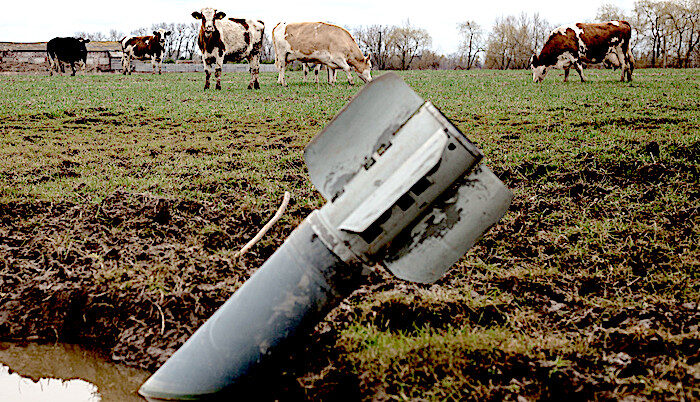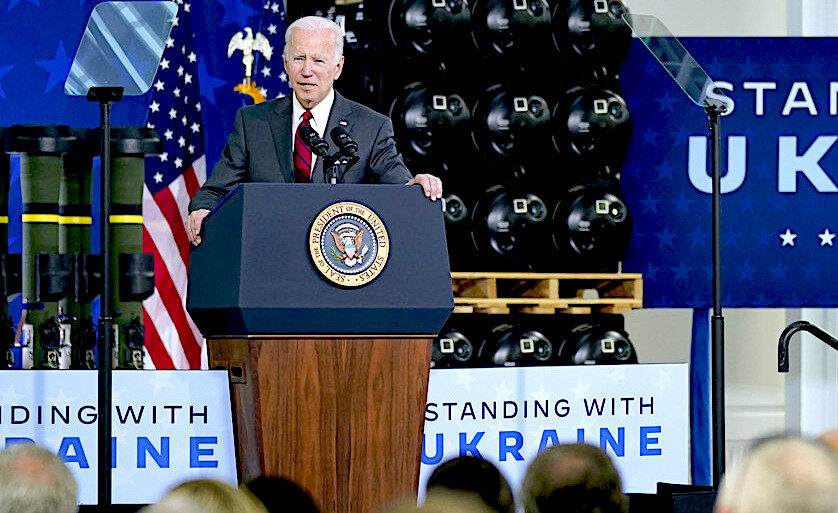Officials across the Ukrainian government have pleaded with the U.S. for months to send the Multiple Launch Rocket System, or MLRS. But three people familiar with the issue say the Ukrainians are concerned that the White House is holding back over worries the weapon could be used to launch strikes inside Russia, thereby expanding and prolonging the conflict.
"There was momentum on it at Ramstein, but that seems to have cooled," said one congressional staffer with knowledge of discussions last month in Germany, where 40 nations gathered to discuss the next steps in arming Ukraine. "There's definitely a frustration building" in Kyiv over these new caveats being placed on military aid, this person said.
The weapon has been near the top of Ukrainian requests for months, and military and civilian leaders in Kyiv have made their case to their American counterparts directly on multiple occasions.
A Biden administration official who asked to remain anonymous to discuss internal deliberations told POLITICO that the two countries remain "in active discussion" about the weapon, but that even with the $3.8 billion worth of military aid the U.S. has sent Ukraine since Russia's Feb. 24 invasion, not everything Kyiv asks for can be sent quickly.
"We have to make decisions about what weapons systems provide the biggest bang for the buck," with the money Congress allots to the Ukraine effort, the official said. Over the past several weeks as the latest funding package began to be whittled down, the administration decided "it was more effective and efficient to send the 90 M777 [howitzers] because you can send more of them" and more munitions for the price than a much smaller number of MLRS.
The U.S. has quietly provided older, Soviet-era multiple launch rocket systems to Ukraine over the past several months after scouring the warehouses of allies who still operate the older weapons. But the more precise, more powerful American systems are what Kyiv is looking for to blunt Russian advances in the Donbas.
But worries persist in the White House that sending the system or its cousin, the High Mobility Artillery Rocket System, could be seen as an escalation by the Kremlin, given the weapon's longer range and greater destructive power than traditional artillery such as howitzers, or the older Soviet rocket launchers.
The M270 Multiple Launch Rocket System was first produced for the U.S. Army in 1983, and was designed specifically to quickly fire 12 rockets and drive off quickly to reload before Soviet artillery zeroed in. It is still in use by over a dozen countries, and depending on the munition used, its range generally stretches from 20 miles to 40 miles, with the most advanced rockets being able to travel over 100 miles.
Russian President Vladimir Putin's invasion so far has been a story of battlefield humiliation, with a string of failed offensives that have left thousands of troops dead and torn apart armored units. Those losses, and Putin's long-cultivated unpredictability, have given rise to some wariness that the weapons — which can fire rockets farther than anything the Ukrainians currently possess — could move the needle closer to Russia resorting to the use of chemical weapons or other weapons of mass destruction.
Comment: Politico is running the pre-determined MSM narrative. Russia is NOT incompetent, nor does it overestimate its capabilities which are more than formidable, perhaps the best on the planet.

Officials in Kyiv have complained that the longer the West dithers over sending the full complement of weapons it needs, the direr the consequences for Ukraine's civilians and allows Russia more time to conduct sham local elections in areas it controls.
"With this in mind, we want to defeat the enemy and liberate our territories as soon as possible," Ukrainian Defense Minister Oleksii Reznikov told the European Union Foreign Affairs Council Tuesday. Ukraine wants to buy weapons quickly, he added, including "tanks, armored vehicles, long-range fire weapons systems (MLRS, heavy artillery, aircraft, missiles)," according to prepared remarks.
Comment: Buying weapons with US billions would make the MIC smug and richer...
Speaking at a virtual G-7 leaders' summit this month, Ukrainian President Volodymyr Zelenskyy was more specific, telling the leaders his country
"must receive all the weapons and all the defense equipment that will allow the defeat of tyranny — in particular the M142 HIMARS and M270 MLRS multiple launch rocket systems and other weapons that Ukraine requested from your powerful states."Longer range, bigger punch
Produced by Lockheed Martin, the MLRS would allow Ukrainian troops to fire from relatively safe standoff distances and quickly pack up and move before Russian drones and artillery could spot their location.
It's a very different weapon than the M777 howitzers the Biden administration dispatched to Ukraine over the past several weeks, which Russian troops have started to target with loitering munitions along their static firing lines. Those cannons have a range of about 18 miles but can fire one only shell at a time and must be towed behind a truck to move from location to location.
The howitzers are already in the fight and have made a difference in targeting Russian supply bases and columns in the East, but the rocket system would be a leap in firepower as the war evolves into a struggle between heavy artillery, mortars and airstrikes.
Comment: Escalation is not the answer! Unless you are the US desiring to assess Russia's strengths and weaknesses at the expense of Ukraine.
"From the Russian point of view, it presents a real threat that their artillery can be taken out before it can even get in range to shoot," said Dmitry Gorenburg, a Russia specialist at nonprofit research institute CNA.
Overall, Ukrainian troops have performed better than most analysts predicted, pushing the Russians back from the capital of Kyiv and retaking the northeastern city of Kharkiv over the past several days. Over the weekend, the Ukrainian Ministry of Defense shared a video of a group of soldiers posing at the Russian border to the east of the city. "We have made it. We are here, Mr. President," one of the soldiers said.
Comment: It was not Russia's intention to capture Kyiv. It purposefully avoided massive conflict. Pushback by Ukraine is an optic.
The Biden administration has already supplied the Ukrainian military with $4.5-billion worth of weapons and supplies, including $3.8 billion since Russia's Feb. 24 invasion. The aid in those first weeks consisted mainly of shoulder-launched anti-armor and anti-air missiles and ammunition.
As the war has changed, however, and Ukrainian forces have gone on offense in some areas to retake territory captured by Russia, the U.S. and U.K. have also pivoted, stepping over self-imposed limitations on providing only defensive weapons to those clearly capable of offensive operations.
Those packages have included howitzers, missiles, armored vehicles, radar systems, tanks, and kamikaze and surveillance drones rushed to the front as the fight moved from close combat in the suburbs of Kyiv to artillery battles in the Donbas.
The new weapons are more in tune with the stand-off fights in the East, where the Ukrainians are trying to push Russian forces out of artillery range of towns and cities.
A British intelligence assessment released Tuesday warned that
"in the coming weeks, Russia is likely to continue to rely heavily on massed artillery strikes as it attempts to regain momentum in its advance in the Donbas."The state of U.S. weapons transfers to Ukraine is in flux. The president's drawdown authority — the amount of equipment he can draw from U.S. stockpiles to send to Ukraine — has fallen to about $100 million, a hefty sum but one that limits what can go next until more funding is freed up.
But more funding could start flowing as soon as this week, as Congress is expected to vote on a $40 billion military and humanitarian aid package for Ukraine and Eastern Europe, opening the floodgates to about $20 billion more in U.S. military support for Ukraine.




Although I feel dirty after reading this, keeping track of what both sides are doing and saying is important.